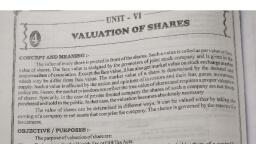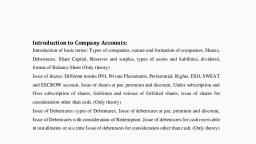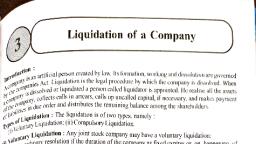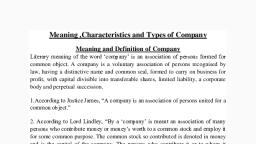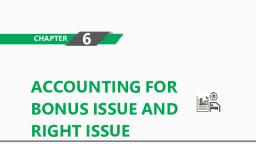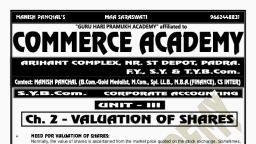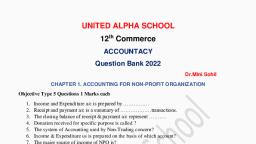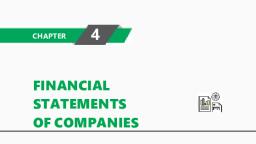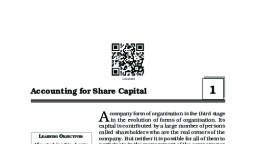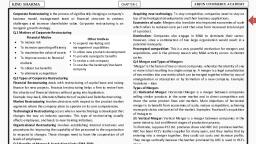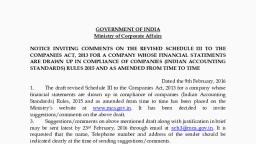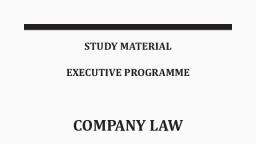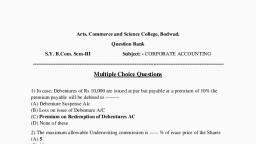Page 1 :
Management Accounting, , Welcome to all, COMPANY ACCOUNTS, 1
Page 2 :
●, , ●, , ●, , ●, , The word ‘company’ is derived from the Latin word ‘com’ i.e. with or together, and ‘panis’ i.e. bread., The word referred to an association of persons or merchant men discussing, matters and taking food together, Lord Justice Hanay has defined a company as “an artificial person created by, law with a perpetual succession and a common seal”., In law ‘company’ is termed as company which is formed and incorporated, under the Companies Act, 2013 or an existing company formed and registered, under any of the previous company laws., 2
Page 3 :
FEATURES OF A COMPANY, ●, , Incorporated Association, , ●, , Separate Legal Entity, , ●, , Perpetual Existence, , ●, , Common Seal, , ●, , Limited Liability, , ●, , Separation of Ownership and Management, , 3
Page 4 :
FEATURES OF A COMPANY, ●, , Not a citizen, , ●, , Transferability of Shares, , ●, , Maintenance of Books, , ●, , Periodic Audit, , ●, , Right of Access to Information, , 4
Page 5 :
TYPES OF COMPANIES, ●, , Government Company-, , 2(45)-51%, , ●, , Foreign Company-2 (42)- incorporated outside India, , ●, , which –, –, , (a) Has a place of business in India whether by itself or through an agent, physically or through electronic mode; and, , –, , (b) Conducts any business activity in India in any other manner., , 5
Page 6 :
Private Company-2(68), ●, , Restrict the right to transfer its shares, , ●, , Number of its members:2-200, , ●, , Prohibits any invitation to the public to subscribe for any, securities of the company. Shares of a Private Company are not, listed on Stock Exchange., , 6
Page 7 :
Public Company-2(71), ●, , It is not a private company, , ●, , No Minimum Paid-up Share Capital, , ●, , One Person Company-2 (62), , ●, , Unlimited Company -2 (92), , ●, , Listed Company -2 (52), , ●, , Company limited by Shares-2(22), , ●, , Company limited by Guarantee-2(21), 7
Page 8 :
Small Company-2(85), ●, , a company, other than a public company, , ●, , (i) paid-up share capital of which does not exceed fifty lakh rupees, or such higher amount as may be prescribed which shall not be more than five, crore rupees; or, , ●, , (ii) turnover not exceed two crore rupees, or such higher amount as may be prescribed which shall not be more than twenty, crore rupees:, , ●, , Note: The status of a company as a Small Company may change from year to year., , 8
Page 9 :
Holding Company-2 (46) and Subsidiary Company-2(87), ●, , ●, , (i) Controls the composition of the Board of Directors; or, (ii) Exercises or controls more than one-half of the total share, capital either at its own or together with one or more of its, subsidiary companies., , 9
Page 10 :
10
Page 11 :
PREPARATION OF FINANCIAL STATEMENTS-2(40), ●, , Balance sheet as at the end of the financial year, , ●, , Profit and loss account or income and expenditure account, , ●, , cash flow statement for the financial year, , ●, , Statement of changes in equity, if applicable; and, , ●, , Any explanatory note, NB:O P C, Small Company and dormant company, may not include, the cash flow statement., 11
Page 12 :
Requisites of Financial Statements-Provisions, ●, , Balance Sheet as per Form set out in Part I of Schedule III, , ●, , Statement of Profit and Loss as per Part II of Schedule III, Other than Insurance company,Banking company and any, company engaged in generation or supply of electricity., , 12
Page 13 :
13
Page 14 :
14
Page 15 :
ISSUE, FORFEITURE AND RE-ISSUE OF SHARES, , 15
Page 16 :
SHARE CAPITAL, ●, , Authorised Share Capital or Nominal Capital (Issued + Unissued), , ●, , Issued Share Capital & Unissued Capital, Cash, and Consideration other than cash to, Promoters of a company and Others., , ●, , Subscribed Share Capital, , ●, , Called-up Share Capital & Uncalled Capital, –, , (Paid up Capital + Calls in arrears– Calls in advance), , ●, , Paid-up Share Capital ‘unpaid calls’ or ‘instalment (or Calls) in Arrears, , ●, , Reserve Share Capital, 16
Page 17 :
TYPES OF SHARES-Preference Shares, , ●, , Preference Share Holders enjoy preferential rights for, –, , (a) Payment of dividend, and, , –, , (b) Repayment of capital, , –, , Preference Share holders of these shares do not get voting rights, , 17
Page 18 :
Types of Preference Shares, ●, , Cumulative Preference Shares, , ●, , Non-cumulative Preference Shares, , ●, , Participating Preference Shares(right to participate in the surplus profits), , ●, , Non-participating Preference Shares (Unless otherwise stated, this type), , ●, , Redeemable Preference Shares, , ●, , Non-redeemable Preference Shares ( maximum period is 20 years), , ●, , Convertible Preference Shares, , ●, , Non-convertible Preference Shares(unless otherwise stated, this type), 18
Page 19 :
Cumulative Preference Shares, ●, , ●, , ●, , The arrears of dividend are shown in the balance sheet as a, contingent liability, Unless otherwise stated,Preference share is considered cumulative, The dividend remains in arrears for a period of not less than two, years, holders of such shares will be entitled to take part and vote, on every resolution on every matter in the general body meeting of, the shareholders, , 19
Page 20 :
TYPES OF SHARES-Equity Shares, ●, , ●, , Equity Share holders do not enjoy any preferential rights in the, matter of payment of dividend or repayment of capital., The rate of dividend is recommended by the Board of Directors, and may vary from year to year, , 20
